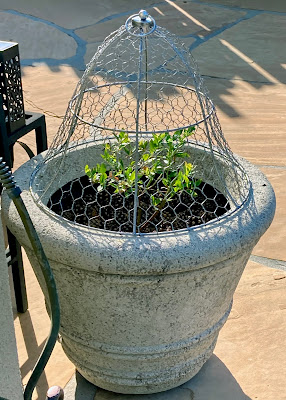Cloches
I found a solution for protecting some of my smaller plants from rabbits. It's a chicken wire bell that just sits over the plant.
This type of protection -- a cloche -- is an old method of covering plants. Usually cloches are for frost protection; they are enclosed glass or plastic domes that keep cold air off new spring leaves or to give new seedlings a warm greenhouse start. They are temporary when used that way.
My chicken wire cloches are almost invisible against a background of gravel (almost). This grama grass was shorn to the ground all last season but this year, safe inside its wire bell, it is growing.
Set atop a container, the wire cloche keeps birds from eating the blueberries on my little potted plant. It fits exactly the dimensions of the rim of this container. I just have to lift the cloche to get at the blueberries and set it back down to protect the plant. It's weighty enough to stay put.
I don't actually have any blueberries yet, but. . . . eventually. When I do, this is so much easier than dealing with netting draped over the plant. This cloche won't fit over a much bigger, bushier blueberry plant, but for now while it's little, it works.
Gardeners have long used netting or chicken wire to fashion barriers for their small plants or for wrapping tree trunks to keep gnawers away. I have done that many times before. A bunch of netting or stiff wire globbed around a vulnerable plant works fine but isn't all that attractive, so when I saw these lovely bell shaped wire cloches, I thought they were perfect.
The rabbits don't think so, but I do.





Comments